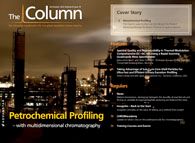Hydrogel delivery
Drug bioavailability, the rate at which the active compound of a drug becomes available at the site of action, is key to the successful development of new drugs. The development of hydrogels, self-assembling polymer-based scaffolds, has rapidly accelerated in recent years because of their potential in the improvement of drug bioavailability.
Drug bioavailability, the rate at which the active compound of a drug becomes available at the site of action, is key to the successful development of new drugs. The development of hydrogels, self-assembling polymer-based scaffolds, has rapidly accelerated in recent years because of their potential in the improvement of drug bioavailability.
Hydrogels can be engineered in a number of ways depending on the desired function. Scientists in Japan1 have recently demonstrated the use of a gelatin based hydrogel for the successful administration of a bio therapeutic anti-cancer compound to colon cancer cell lines, reducing the rate of proliferation and migration.
The scientists encapsulated a bioactive lipid, cyclic phosphatidic acid (cPA), within a gelatine scaffold and observed the effect on the growth of a cell-line derived from colon cancer. Electrospray ionization liquid chromatography–mass spectrometry (ESI–MS) and thin-layer chromatography (TLC) analysed cPA release from the scaffold and the rate of degradation. It was found that encapsulation of the drug within the hydrogel improved the lifetime of the drug post-administration by protecting it from degradation, in addition to allowing the gradual release of the drug.
1. Tamotsu Tsukahara and K Murakami-Murofushi, Nature Scientific Reports,2(687), (2012).
This story originally appeared in The Column. Click here to view that issue.

Removing Double-Stranded RNA Impurities Using Chromatography
April 8th 2025Researchers from Agency for Science, Technology and Research in Singapore recently published a review article exploring how chromatography can be used to remove double-stranded RNA impurities during mRNA therapeutics production.
The Effect of Time and Tide On PFAS Concentrations in Estuaries
April 8th 2025Oliver Jones and Navneet Singh from RMIT University, Melbourne, Australia discuss a recent study they conducted to investigate the relationship between tidal cycles and PFAS concentrations in estuarine systems, and offer practical advice on the sample preparation and LC–MS/MS techniques they used to achieve the best results.









